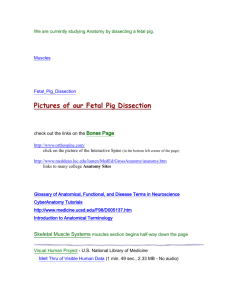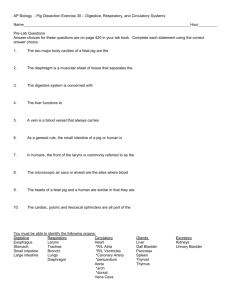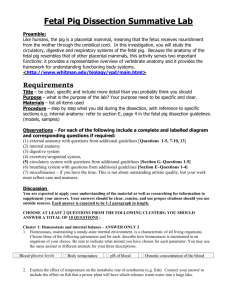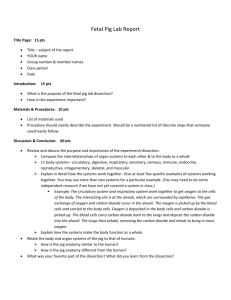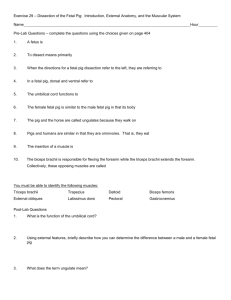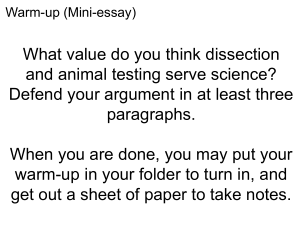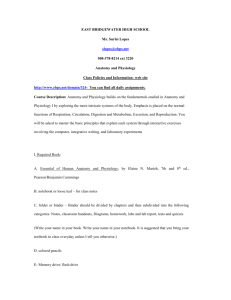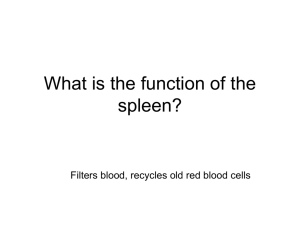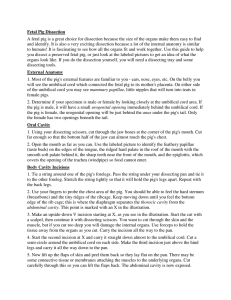5b - Fetal Pig Dissection Lab
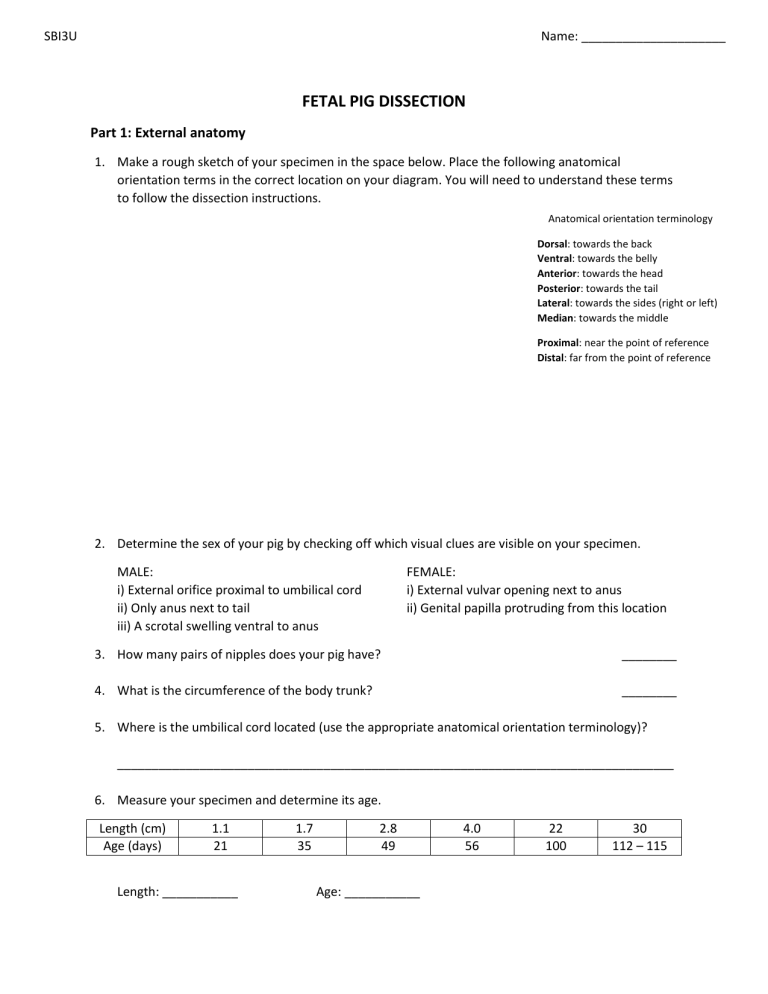
SBI3U Name: _____________________
FETAL PIG DISSECTION
Part 1: External anatomy
1.
Make a rough sketch of your specimen in the space below. Place the following anatomical orientation terms in the correct location on your diagram. You will need to understand these terms to follow the dissection instructions.
Anatomical orientation terminology
Dorsal: towards the back
Ventral: towards the belly
Anterior: towards the head
Posterior: towards the tail
Lateral: towards the sides (right or left)
Median: towards the middle
Proximal: near the point of reference
Distal: far from the point of reference
2.
Determine the sex of your pig by checking off which visual clues are visible on your specimen.
MALE: i) External orifice proximal to umbilical cord ii) Only anus next to tail iii) A scrotal swelling ventral to anus
Length (cm)
Age (days)
FEMALE: i) External vulvar opening next to anus ii) Genital papilla protruding from this location
3.
How many pairs of nipples does your pig have?
4.
What is the circumference of the body trunk?
________
________
5.
Where is the umbilical cord located (use the appropriate anatomical orientation terminology)?
_________________________________________________________________________________
6.
Measure your specimen and determine its age.
1.1
21
1.7
35
2.8
49
4.0
56
22
100
30
112 – 115
Length: ___________ Age: ___________
7.
Observe the toes of the pig. How many toes are on the feet?
Are the toes split or fused?
8.
Feel the edges of the mouth for teeth. Does the fetal pig have teeth?
Are humans born with teeth?
9.
Explore the pharynx of the specimen being sure to note the following structures:
________
________
________
________ i) epiglottis ii) pharynx iii) tracheal opening iv) esophageal opening
10.
Observe the eyes of the pig. Carefully remove the eyelid so that you can view the eye underneath.
Does it seem well developed? Do you think pigs are born with their eyes open or shut?
_________________________________________________________________________________
11.
Label Figure 1 and 2 below:
Quality of Dissection Checklist:
Before you begin making primary incisions be aware that you will receive a mark based on the quality of your surgical skills. The following checklist will be used to qualitatively assess your success:
Liver undamaged /1
Abdominal & thoracic flaps neatly pinned back /2
Diaphragm tidily cut
Digestive system exposed and intact
Heart and lungs exposed and intact
/1
/1
/1
Tracheal cartilage rings clearly visible /1
Umbilical cord and structures underneath visible /1
Safe procedures are followed at ALL times /2 TOTAL /10
Safety Rules & Respectful Procedure
Gloves, an apron should be worn. Long hair tied back. No food or drink in lab! Textbooks, phones and other items stored to the side.
Your specimen should be treated with respect at all times and under no circumstances should excised body parts leave the dissecting tray.
Hold the scalpel like a pencil and ALWAYS have an instrument in each hand at all times.
Always angle upwards when cutting with scissors to avoid damaging structures.
-
If at any time you feel the need to leave the room please feel free to do so but BEFORE YOU DO, be sure to remove your gloves to avoid contaminating any surfaces.
Part 2: Respiratory anatomy
1.
What is the name of the body cavity that holds the lungs?
_________________________________________________________________________________
2.
What is the function of the larynx?
_________________________________________________________________________________
3.
What keeps the trachea from collapsing?
_________________________________________________________________________________
4.
Is the diaphragm of the fetus functional? Explain.
_________________________________________________________________________________
5.
What keeps the trachea from collapsing?
_________________________________________________________________________________
6.
Name the large tubes that enter the left and right lungs:
_________________________________________________________________________________
Name the smaller tubes that branch from the tubes mentioned above
_________________________________________________________________________________
7.
Describe the appearance and texture of the interior of the lungs:
_________________________________________________________________________________
________________________________________________________________________________
8.
Label the diagram below:
Part 3: Circulatory anatomy
1.
What is the pericardium?
_________________________________________________________________________________
2.
Describe any differences between the atria and ventricles that you feel with your fingers:
_________________________________________________________________________________
_________________________________________________________________________________
3.
Into what heart chamber does the superior and posterior vena cava open?
_________________________________________________________________________________
4.
From what chamber does the aorta arise?
_________________________________________________________________________________
5.
What is the function of coronary circulation?
_________________________________________________________________________________
6.
Label the diagram below:
Part 4: Digestive anatomy
1.
Where does the digestive tract start and end?
_________________________________________________________________________________
2.
What is the purpose of saliva?
_________________________________________________________________________________
3.
What is the function of the epiglottis?
_________________________________________________________________________________
4.
How do fetal pigs receive nourishment from their mother?
_________________________________________________________________________________
5.
The stomach of a fetal pig won’t be completely empty because they drink what fluid?
_________________________________________________________________________________
6.
How many lobes does the pig’s liver have?
_________________________________________________________________________________
What is the liver’s function?
_________________________________________________________________________________
7.
What is the function of the gall bladder and pancreas?
_________________________________________________________________________________
8.
Locate the following sphincters in the specimen’s digestive tract: esophageal, cardiac, pyloric.
What is their respective function?
_________________________________________________________________________________
_________________________________________________________________________________
9.
What is the jejunum and ileum?
_________________________________________________________________________________
10.
What is another name for the large intestine and what is its function?
_________________________________________________________________________________
11.
To the best of your ability measure the length of the small intestine and large intestine.
Large intestine length: ____________ Small intestine length: ____________
12.
Label the diagram below:
Part 5: Urogenital anatomy
1.
In order, name the structures through which urine passes from the kidneys:
2.
Label the parts of these two diagrams:
Part 6: Nervous system anatomy
1.
Name the protective membrane that covers the brain:
2.
What part of the skeleton protects the brain?
__________________________
__________________________
3.
Give the function of the following structures:
Cerebrum: ________________________________________________________________________
Cerebellum: _______________________________________________________________________
Medulla oblongata: _________________________________________________________________
Spinal cord: _______________________________________________________________________
